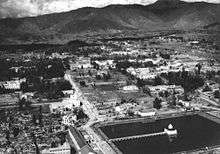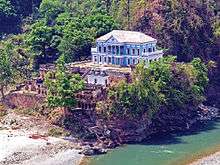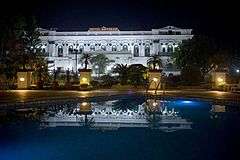Rana palaces of Nepal
The Rana palaces of Nepal were built by the Rana dynasty rulers of Nepal as both private and government buildings. The Rana rule lasted for 104 years, and during that time a number of grand royal residences were built, especially by the Prime Minister, his immediate family, and other high-ranking dignitaries.
The grand palaces of Rana were called white elephants and stood at the center of vast expanses of landscaped grounds, which Rana rulers used to show their supremacy over the common people, and to please their British friends and fellow Ranas.[1] After the overthrow of the Rana Dynasty, some palaces were converted into government buildings. Others were demolished by their owners and rebuilt into libraries, museums, hotels, and heritage complexes.[2] Most palaces still in private ownership have been destroyed or lie in ruins. Most government-owned palaces have been maintained and restored.



Basic Information
Most of the Rana palaces are white plastered, have been built in Neoclassical or Baroque European architectural style, and are made up of four wings with arresting French windows, Grecian columns, and a large courtyard in the middle for religious and ceremonial purposes. The internal beams and columns of these palace are made of Salla Pinus roxburghii wood.[3] Traditional mortar and white plaster, along with bricks, were used in construction. Black lentil paste, molasses, brick dust, mustard meal, and limestone powder were used in the cementing and plastering mixture. Lime-plaster (Bajra), a mixture of molasses, black pulse, jute, brick dust and lime, was the main ingredient for plaster as it had been for centuries in Nepal, primarily as it had good resistance against humidity. The floors were constructed using battens, rectangular in shape, above which planks were laid. These in turn supported the final floor, on which square-shaped slates were laid.[3] Foreign-trained Newar architects designed most of the palaces.[2]
Palaces



| Palace | Commissioned By | Date of Construction | Engineer |
|---|---|---|---|
| Thapathali Durbar | Jung Bahadur Rana | Late 1700s-1860s | Initial Unknown, Later by Ranasur Bista |
| Singha Mahal | Jung Bahadur Rana | 1855 CE | Ranasur Bista |
| Charburja Durbar | Jung Bahadur Rana | 1855 CE | Ranasur Bista |
| Gol Baithak | Jung Bahadur Rana | 1852 | Ranasur Bista |
| Narayanhity Durbar | Bir Shumsher JBR | Jogbir Sthapit | |
| Lal Durbar | Bir Shumsher JBR | 1890 | Jogbir Sthapit |
| Seto Durbar | Bir Shumsher JBR | 1893 | Jogbir Sthapit |
| Bhatbhateni Durbar | Bir Shumsher JBR | 1893 | Jogbir Sthapit |
| Jaulakhel Durbar | Bir Shumsher JBR | 1897 | Jogbir Sthapit |
| Pani pokahari Durbar | Bir Shumsher JBR | 1885 | Jogbir Sthapit |
| Phohora Durbar | Bir Shumsher JBR | 1896/97 | Jogbir Sthapit |
| Hatti Shar Durbar | Bir Shumsher JBR | Jogbir Sthapit | |
| Lazimpat Durbar | Kaji Bir Keshar Pande[2] and later re commissioned by Bir Shumsher JBR | 1894 | Jogbir Sthapit |
| Tangal Durbar | Bir Shumsher JBR | 1889 | Jogbir Sthapit |
| Muduli Durbar | Bir Shumsher JBR | 1893/92 | Unknown |
| Bhanjaraja Durbar | Probably Bir Shumsher JBR | Unknown | Unknown |
| Singha Durbar | Chandra Shumsher JBR | 1908 | Kumar Narsingh Rana, Kishor Narsingh Rana |
| Kaiser Mahal | Chandra Shumsher JBR | Kumar Narsingh Rana, Kishor Narsingh Rana | |
| Shree Durbar | Chandra Shumsher JBR | 1927 | Kumar Narsingh Rana, Kishor Narsingh Rana |
| Sithal Niwas | Chandra Shumsher JBR | 1923 | Kumar Narsingh Rana, Kishor Narsingh Rana |
| Lakshmi Niwas | Chandra Shumsher JBR | 1905 | Kumar Narsingh Rana, Kishor Narsingh Rana |
| Harihar Bhawan | Chandra Shumsher JBR | Kumar Narsingh Rana, Kishor Narsingh Rana | |
| Babar Mahal | Chandra Shumsher JBR | Kumar Narsingh Rana, Kishor Narsingh Rana | |
| Man Bhawan | Juddha Shumsher JBR | Unknown | |
| Kalimati Durbar | Juddha Shumsher JBR | Unknown | |
| Narayan Bhawan | Juddha Shumsher JBR | Unknown | |
| Surendra Bhawan | Juddha Shumsher JBR | Unknown | |
| Kalimati Durbar | Juddha Shumsher JBR | Unknown | |
| Narayan Bhawan | Juddha Shumsher JBR | Unknown | |
| Shashi Bhawan | Juddha Shumsher JBR | Unknown | |
| Hiti Durbar | Kaji Dhokal Singh Basnyat | Unknown | |
| Bahadur Bhawan | Rudra Shumsher JBR | Unknown | |
| Manohara Durbar | Jagat Jung Rana | 1879 | Unknown |
| Ranighat Palace | Khadga Shumsher JBR | 1893 | Unknown |
| Tansen Durbar | Pratap Shamsher Jang Bahadur Rana | 1927 | Unknown |
| Minbhawan Palace | Min Shumsher | Unknown | Unknown |
| Rabi Bhawan Palace | Rabi Shumsher | Unknown | Unknown |
| Bagh Durbar | Amar Singh Thapa (Sanu)[note 1](Father of Bhimsingh Thapa) | Unknown |
Earthquake of 2015
The earthquake of 2015 resulted in the destruction of many remaining palaces, particularly those built of mud-mortar brick and lime plaster.
See also
References
- Not to be confused with the better known commander of Gorkhali forces in the Gurkha War with the same name. The two Amar Singhs are differentiated by the qualifier Bada (greater) and Sanu (lesser).
| Wikimedia Commons has media related to Rana palaces in Nepal. |
- .thetaranights.com. 29 May 2014. Retrieved on 2015-07-27.
- JBR, PurushottamShamsher (2007). Ranakalin Pramukh Atihasik Darbarharu [Chief Historical Palaces of the Rana Era] (in Nepali). Vidarthi Pustak Bhandar. ISBN 978-9994611027.
- http://www.thetaranights.com/baghdurbar-the-tiger-palace/
